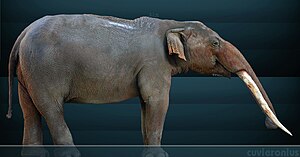Cuvieronius
| Cuvieronius | ||||||||||||
|---|---|---|---|---|---|---|---|---|---|---|---|---|

Live reconstruction of Cuvieronius hyodon |
||||||||||||
| Temporal occurrence | ||||||||||||
| Pliocene to Late Pleistocene | ||||||||||||
| ? Million years to 11,000 years | ||||||||||||
| Locations | ||||||||||||
|
||||||||||||
| Systematics | ||||||||||||
|
||||||||||||
| Scientific name | ||||||||||||
| Cuvieronius | ||||||||||||
| Osborn , 1923 | ||||||||||||
Cuvieronius ( Syn. : Cordillerion ) was a Rüsseltier genus of the family Gomphotheriidae and lived in the Pliocene and Pleistocene in America.
Appearance
Cuvieronius differs from Notiomastodon , who lived in South America at the same time, by its broad, long skull, smaller body size and simpler molars (molars). The animals were relatively small (only about 2.2 m long), which was probably an adaptation to mountainous habitats. The distinctive features of the genus were the 2 m long, slightly curved tusks, around which a spiral band of tooth enamel wound, the short symphysis of the lower jaw and the shape of the molars . These had a lophodontic structure with transverse tooth enamel bands , the front two molars each having three of these enamel bands, which is characteristic of trilophodontic gomphotheria. The last molar, on the other hand, comprised four or five enamel ridges. The end points of the respective strips were slightly offset from one another. It is conceivable that the South American species, which was found in quite inhospitable habitats, even had a fur.
distribution
Cuvieronius lived from the Pliocene to the Pleistocene in southern North America from Arizona to Florida . From there it reached South America via the Central American land bridge, where it has been documented from the Late Pliocene. It survived into the late Pleistocene, possibly even the Early Holocene. Only one species, Cuvieronius hyodon, is known from South America . This was limited to the Andes region and lived in what is now Ecuador, Peru, Bolivia, Chile and western Argentina. The genus disappeared along with many other large animal species from South America at the beginning of the Holocene as part of a worldwide Quaternary extinction wave .
Way of life
Cuvieronius hyodon was a mountain dweller whose habitat was mainly the high plateaus of the Andes up to an altitude of about 4000 m (Peru). In contrast to the other South American gomphotheries, which were more likely to be found in warm zones, Cuvieronius could also have coped with cool weather conditions. Based on isotope studies on the teeth, it was found that the animals apparently ate both leaves and grass.
Systematics
Cuvieronius belongs to the trilophodontic gomphotheria, which are characterized by three enamel bands on the first two molars. Within the gomphotheres the genus belongs to the phylogenetically younger subfamily of Rhynchotheriinae, maybe it arose from the widespread also in Central and South America Rhynchotherium .
Several species have been described by Cuvieronius . Until recently, two of these, Cuvieronius hyodon and Cuvieronius tropicus, were generally recognized. More recent investigations, especially on the molars, did not reveal any systematic differentiation between C. tropicus and C. hyodon , so that the former was equated with the latter and Cuvieronius with C. hyodon currently only includes one species, which is widely recognized today.
Web links
- Skull of Cuvieronius ( Memento from September 28, 2007 in the Internet Archive )
literature
- Paul S. Martin , Richard G. Klein (Eds.): Quaternary Extinctions. A Prehistoric Revolution. The University of Arizona Press, Tucson AZ 1984, ISBN 0-8165-1100-4 .
- Arno Hermann Müller : Textbook of paleozoology. Volume 3: Vertebrates. Part 3: Mammalia. 2nd, revised and expanded edition. Fischer, Jena 1989, ISBN 3-334-00223-3 .
- JL Prado et al .: The Pleistocene Gomphotheres (Proboscidea) from South America: diversity, habitats and feeding ecology. In: G. Cavarretta (Ed.): La terra degli elefanti. = The world of elephants. Atti del 1st congresso internazionale, Roma, 16-20 October 2001. Consiglio nazionale delle ricerche, Rome 2001, ISBN 88-8080-025-6 , pp. 337-340 ( PDF; 42 kB ).
Individual evidence
- ^ A b c Spencer G. Lucas and Guillermo E. Alvarado: Fossil Proboscidea from the Upper Eozoic of Central America: Taxonomy, evolutionary and paleobiogeographic significance. Revista Geológica de América Central, 42, 2010, pp. 9-42
- ↑ a b Rodolfo M. Casmiquela, Jehezekel Shoshani and Thomas D. Dillehay: South American proboscideans: general introduction and reflection on Pleistocene extinction. In: Jeheskel Shoshani and Pascal Tassy (eds.): The Proboscidea. Evolution and palaeoecology of the Elephants and their relatives. Oxford, New York, Tokyo, 1996, pp. 316-320
- ↑ JL Prado MT Alberdi, B. Azanza, B. Sánchez and D. Frassinetti: The Pleistocene Gomphotheres (Proboscidea) from South America: diversity, habitats and feeding ecology. In: G. Cavarretta (Ed.): The World of Elephants - International Congress. Consiglio Nazionale delle Ricerche. Rome 2001, pp. 337-340.
- ↑ María Teresa Alberdi, José Luis Prado, Edgardo Ortiz-Jaureguizar, Paula Posadas and Mariano Donato: Paleobiogeography of trilophodont gomphotheres (Mammalia: Proboscidea). A reconstruction applying DIVA (Dispersion-Vicariance Analysis). Revista Mexicana de Ciencias Geológicas 28 (2), 2011, Sp. 235-244
- ↑ Jan van der Made: The Evolution of the Elephants and their relatives in the context of a changing climate and geography. In: Harald Meller (Hrsg.): Elefantenreich - Eine Fossilwelt in Europa. Halle / Saale, 2010, pp. 340–362.
- ^ María Teresa Alberdi, José Luis Prado and R. Salas: The Pleistocene Gomphotheriidae (Proboscidea) from Peru. New yearbook of geological-palaeontological treatises 231, 2004, pp. 423–452.